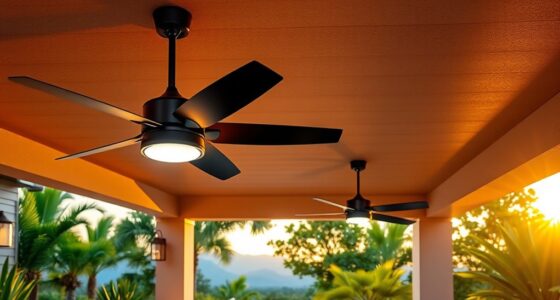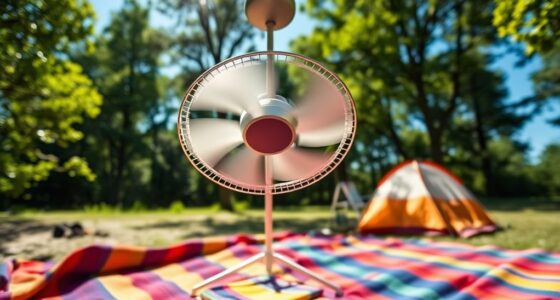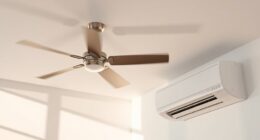The switch on your ceiling fan controls its operation and blade direction, which helps you adjust for comfort and efficiency all year round. You can set the fan to rotate counterclockwise in summer for a cooling breeze, making the room feel up to 4°F cooler. In winter, switching to clockwise redistributes warm air, keeping your space warm without needing to raise the thermostat. This simple adjustment can save on heating and cooling costs. Understanding how to use the switch effectively can truly enhance your home's comfort level. There's a lot more to explore about maximizing your fan's potential!
Key Takeaways
- The switch on a ceiling fan controls the fan's operation, allowing you to turn it on or off.
- It enables you to change the blade rotation direction: clockwise for winter and counterclockwise for summer.
- Clockwise rotation creates an updraft to distribute warm air during colder months.
- Counterclockwise rotation generates a downdraft, enhancing cooling by creating a wind chill effect in warmer months.
- Modern fans often include a remote control for easy adjustments to the switch settings.
Understanding the Ceiling Fan Switch

When you flip the switch on your ceiling fan, you're not just turning it on or off; you're also controlling the direction of the blades. This ceiling fan switch allows you to choose between clockwise and counterclockwise rotation, which greatly impacts your comfort and energy efficiency throughout the year.
In the winter, setting the blades to spin clockwise creates an updraft, circulating warm air that naturally rises to your ceiling. This simple adjustment can help maintain a cozy environment without cranking up the thermostat.
Conversely, when summer rolls around, you'll want to switch the fan to counterclockwise. This setting creates a downdraft, providing a revitalizing cooling breeze that enhances comfort while keeping your cooling costs down.
Most modern fans come with a visible ceiling fan switch on the motor or even a remote control, making it easy to adjust the direction as the seasons change.
Seasonal Fan Direction Adjustments

Seasonal fan direction adjustments can make a significant difference in your home's comfort and energy efficiency. By changing the ceiling fan direction based on the season, you can maximize both cooling and heating benefits.
In summer, set your fan to rotate in the counterclockwise direction. This creates an invigorating downdraft, enhancing the wind chill effect and making the room feel up to 4°F cooler. You'll enjoy cool air without cranking down the thermostat, which can lead to energy savings.
As the seasons change and temperatures drop, it's time to switch to the clockwise direction. This adjustment helps distribute warm air that collects near the ceiling, creating an updraft that sends warmth back down into your living space.
Using a fan remote makes this shift simple and convenient, ensuring peak airflow for seasonal comfort.
Benefits of Proper Fan Direction

Proper fan direction can greatly enhance your home's comfort and energy efficiency throughout the year. By changing your ceiling fans according to the seasons, you can optimize airflow for both cooling and heating needs. Additionally, understanding the principles of heat pump mechanics can further inform your approach to maintaining a comfortable indoor environment, as energy-efficient heat pumps can work synergistically with ceiling fans to improve overall climate control. Furthermore, a comprehensive energy efficiency evaluation can help identify additional strategies to maximize your home's performance. Modern heat pumps often include advanced filtration systems that complement the airflow provided by ceiling fans, ensuring a healthier indoor environment.
| Season | Fan Direction | Effect on Airflow | Energy Savings | Comfort Levels |
|---|---|---|---|---|
| Summer | Counterclockwise | Creates a downdraft | Up to 30% savings | Cooler temperatures |
| Winter | Clockwise | Generates a gentle updraft | Up to 15% savings | Warmer, even heat |
| Year-round | Adjust as needed | Enhances overall airflow | Varies by use | Improved comfort |
In summer, setting the fan direction counterclockwise helps create a downdraft, making you feel cooler and reducing your reliance on air conditioning. In winter, switching the fan to rotate clockwise redistributes warm air near the ceiling, enhancing heating efficiency. This simple adjustment can considerably impact your energy bills and comfort levels. Additionally, utilizing a properly adjusted fan can aid in optimizing your home's energy efficiency when combined with other smart home devices.
Energy Savings With Ceiling Fans

Ceiling fans not only enhance comfort but also play an essential role in cutting energy costs. By using a ceiling fan, you can raise your thermostat settings by up to 4°F during the summer months without sacrificing comfort.
When you run the fan counterclockwise, it creates a cool breeze that helps you feel cooler, reducing your reliance on air conditioning and potentially saving you up to 30% on energy expenses.
In the winter, don't forget to change the direction switch to clockwise. This simple adjustment redistributes warm air throughout your home, allowing you to save up to 15% on heating bills.
By combining your ceiling fan with an ENERGY STAR air conditioning unit, you can enhance overall energy efficiency by around 8%.
Proper operation of your ceiling fan can lead to significant energy savings while maintaining a comfortable indoor environment year-round.
Maintenance Tips for Ceiling Fans

To keep your ceiling fan running smoothly and efficiently, regular maintenance is essential. Start by cleaning the ceiling fan blades and motor to remove dust buildup. This simple step can greatly improve the efficiency of your fan and help save on home energy costs.
Don't forget to periodically check the functionality of the direction switch located on the fan. This switch allows you to turn the fan to rotate counterclockwise in the summer and clockwise in the winter, ensuring peak performance year-round.
Make sure the fan is securely mounted to the ceiling by inspecting screws and bolts for any looseness. Loose components can pose safety risks.
Additionally, listen for any unusual noises or vibrations while the fan operates. These can indicate a need for maintenance or repair, so address them promptly.
Finally, if your fan shows signs of wear or isn't functioning properly, consider replacing or repairing it to maintain peak performance and extend its lifespan.
Frequently Asked Questions
Is the Fan Switch up or Down for Summer?
For summer, you want the fan switch in the down position.
This setting lets the ceiling fan rotate counterclockwise, creating a invigorating downdraft that cools you off. Stand under the fan; if you feel air rushing down, it's set correctly.
This helps enhance your comfort and can even allow you to raise your thermostat by a few degrees, potentially saving you energy.
What Is the Little Switch for on a Ceiling Fan?
You might notice a little switch on your ceiling fan, and it's there for a good reason.
This switch lets you change the direction of the fan blades. In summer, you'll want to set it to counterclockwise for that cool breeze.
During winter, switch it to clockwise to push warm air down, making your space cozier.
Adjusting this can even save you money on energy bills, making it a simple yet effective tool.
What Does Flipping the Switch on a Ceiling Fan Do?
You mightn't realize it, but that little switch on your ceiling fan can dramatically change your comfort.
Flipping it adjusts the blade direction, creating either an invigorating downdraft or a cozy updraft. In summer, you'll enjoy a cool breeze, while winter offers warmth by redistributing heated air.
This simple action can even lead to significant energy savings, making your home more comfortable and efficient throughout the year.
It's a small change with a big impact!
What Is the Reverse Switch on a Ceiling Fan For?
The reverse switch on a ceiling fan lets you change the direction of the blades, optimizing air circulation for different seasons.
In summer, you can set it to counterclockwise for a revitalizing breeze that cools your space.
In winter, flip it to clockwise to push warm air down, making your home cozier.
Conclusion
To sum up, knowing the purpose of your ceiling fan switch can really help you take full advantage of your fan's benefits. By adjusting the direction seasonally, you'll keep your home comfortable and save on energy costs. Remember, a little maintenance goes a long way in keeping your fan running smoothly. So, don't leave it to chance—take the reins and enjoy the breeze while keeping your energy bills in check!









